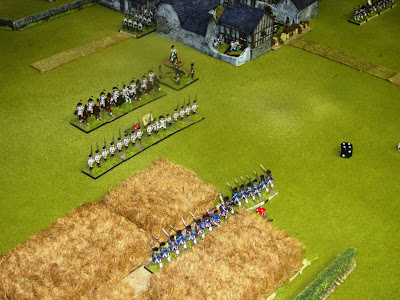Apologies, this game was played a fortnight ago, but as I have only recently regained my beloved broadband internet, it has not previously been possible to tell the tale.
On 1st June von Pritzwalk led his men out against the Khutzewald line. His scouts had reported that it was held rather thinly – in fact only three regiments of infantry and some Dragoons appeared to be there. His inital reaction was to suspect the French of a devious trick, but on 31st May he was informed that the Austrians had attacked in the east and he surmised that this was where Fois-Gras had disappeared to with the bulk of his army.
There were two villages on the line – Pfefferheim, where the Kartoffelwasser stream runs into the Klein-Rhein River, and Tapffheim, further down the Kartoffelwasser. From Tapffheim a series of earthworks ran to the dense Khutzewald forest. Pfefferheim was garrisoned by the Lyonnais regiment; the Kartoffelwasser was watched by the Listenois Dragoons; the Picardie regiment held Tapffheim; and the Champagne regiment manned the earthworks in the south.
Von Pritzwalk’s plan was to feint in the north towards Pfefferheim with the English brigade, while making his main move in the south. By taking Tapffheim he planned to turn the flank of the French and cut the most direct communications with France.
Tapffheim and the earthworks leading to the Khutzewald. Stairs’ Dragoons have just decimated the Champagne regiment. Apologies for the poor photography – it was the first shot of the day!
The first move was to make an overwhelming cavalry attack on the Champagne regiment. This proved to be a spectacular charge, riding over the barrier and cutting the regiment to shreds in a single turn. Victory for the Confederates was looking inevitable! All that was required was for the Dutch Brigade to take Tapffheim, and the victory would be won.
Pfefferheim and Maykit’s over-exuberance costs the Confederates dearly. The Lyonnais regment is building up an impressive record.
Meanwhile, in the north, the diversionary attack went in. Here General Maykit overstepped his brief. Rather than a mere demonstration, he seriously looked to surround and annihilate the garrison of Pfefferheim. In the confusion his two battalion column trying to organise itself to cross the bridge took an age to get ready. The Guards and the Hanoverians threw themselves across the stream and against the walls to no avail. By the end of the day the Hanoverians would be beyond reconstitution as a unit and recalled by the Elector in a fit of rage that his troops were used so brainlessly.
The assault on Tapffheim and the outnumbered and outgunned Picardie regiment fighting bravely. Von Pritzwalk himself is there to ensure that the assault succeeds. At the back is my Prins Georg Danish regiment, which will evetually be part of a four battalion strong Prusso-Danish Brigade.
But while Maykit went mad, Van Klogg calmly directed his Brigade into a two pronged assault. Led by the Welderen and Brandenbourg regiments, not to mention a gun expertly worked and deployed at point blank range, the men of the Grand Alliance surged against the village walls. Picardie fought valiantly, rendering Welderen hors de combat, but in the end numbers and firepower told and Tapffheim fell to the relentless attack.
In the centre the advance elements of Fois-Gras’ men had arrived, tired but ready to help their comrades. First into battle were the Villequier regiment, followed by the Gendarmerie. The Maritime Powers redeployed their cavalry to the centre to combat this growing menace, only to find themselves overpowered. Once again the gentlemen of France had the honour of routing their enemies, but it was all too little, too late. With Tapffheim well in hand and dusk arriving the French cavalry covered the withdrawal of the still defiant Lyonnais regiment from Pfefferheim.
Von Pritzwalk had a hardfought strategic victory, but it would take time to put his force back together and renew the offensive.
An enjoyable game and it was certainly a harder slog than either side had expected! One of the things that I have noticed with the Black Powder rules is the strength of units in built up areas. In a sense this is fair – I can think of a number of circumstances where villages proved especially costly to take - just look at the Battle of Blenheim and the combats at Blindheim and Oberglau. My advice is to mimic the tactics of Marlborough and devote pinning forces to these obstacles and win the battle in the open if at all possible. Of course, as there were no enemy in the open in this game, this was never going to be a workable tactic.
Thanks to John and Terry for helping me to play it out. The next moves in the Wurst War will appear soon hopefully.


























